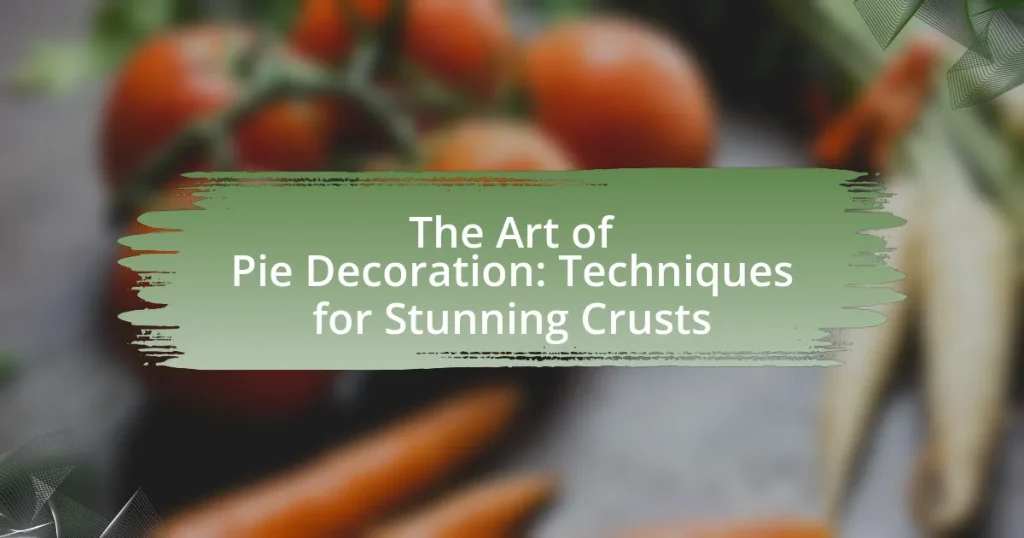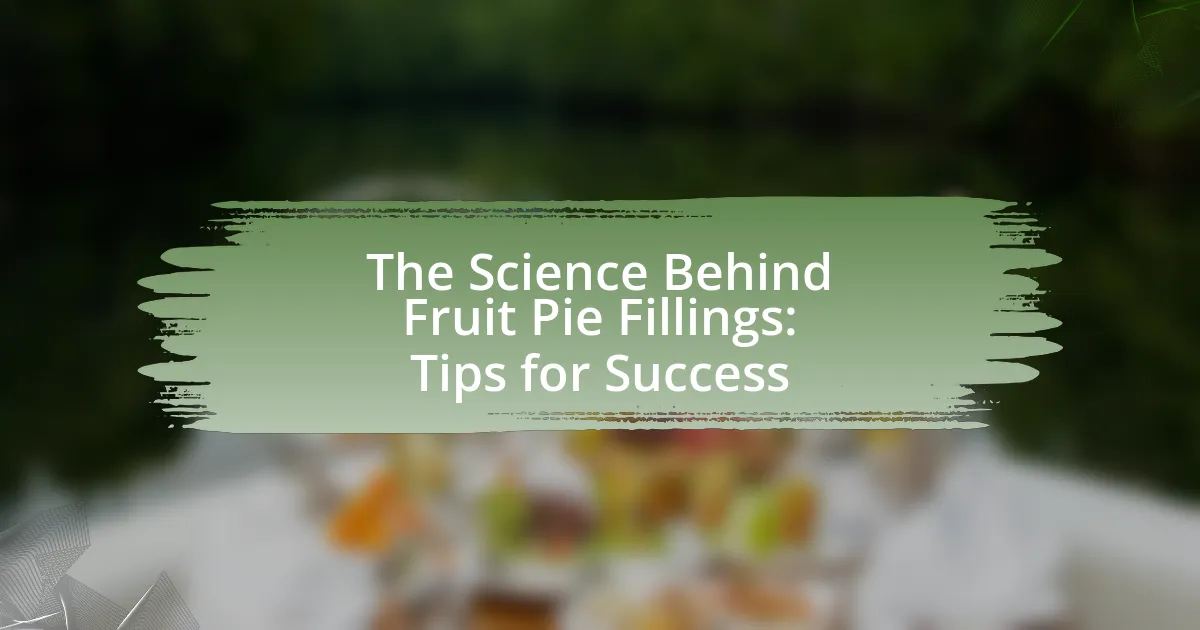The article focuses on the art of pie decoration, detailing fundamental techniques such as lattice crusts, cut-out shapes, and crimping edges. It explores how different types of pie crusts influence decoration methods and highlights the characteristics of flaky and shortcrust pastries. Essential tools for pie decoration, including rolling pins and pastry cutters, are discussed, along with tips for creating intricate designs using stencils and various brushes. Additionally, the article addresses common mistakes in pie decoration and offers troubleshooting advice to enhance the overall presentation and quality of pies.
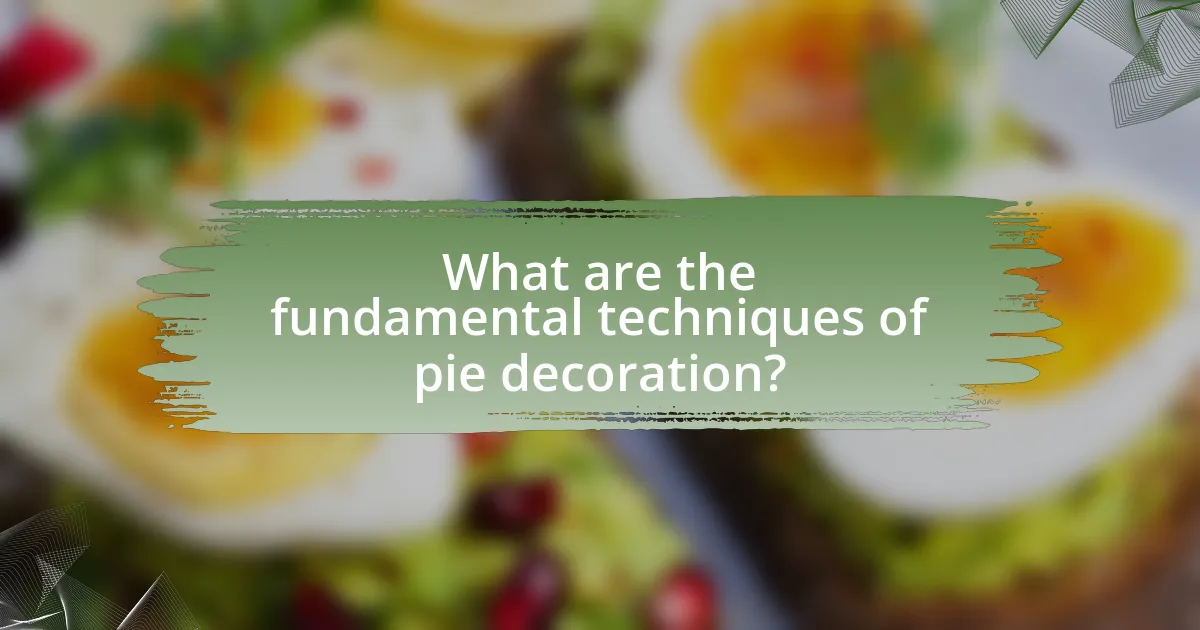
What are the fundamental techniques of pie decoration?
The fundamental techniques of pie decoration include lattice crusts, cut-out shapes, and crimping edges. Lattice crusts involve weaving strips of dough over the filling, creating a visually appealing pattern while allowing steam to escape. Cut-out shapes, such as leaves or stars, can be placed on top of the pie for added decoration and thematic presentation. Crimping edges involves pinching or pressing the dough to create a decorative border, enhancing the overall aesthetic of the pie. These techniques not only improve the visual appeal but also contribute to the pie’s texture and flavor by ensuring even baking and proper sealing of the filling.
How do different types of pie crusts influence decoration techniques?
Different types of pie crusts significantly influence decoration techniques by dictating the texture, structure, and appearance of the final product. For instance, a flaky pie crust, made with cold butter and minimal mixing, allows for delicate decorations like lattice tops or intricate cutouts, as its structure supports light, airy designs. Conversely, a sturdy crust, such as a shortcrust or cookie crust, can handle heavier decorations like whipped cream or fruit toppings, as it provides a solid base that can support additional weight without collapsing. The choice of crust also affects the baking time and temperature, which can further influence how decorations adhere and maintain their shape during the baking process.
What are the characteristics of a flaky pie crust?
A flaky pie crust is characterized by its light, airy texture and distinct layers that create a crisp bite. This texture results from the incorporation of cold fat, such as butter or shortening, which is cut into the flour to form small pockets that expand during baking. The ideal flaky crust also has a balanced ratio of fat to flour, typically around 1:2, which contributes to its tenderness and prevents it from becoming tough. Additionally, the use of cold water helps to keep the fat solid, further enhancing the flakiness.
How does a shortcrust differ from a puff pastry in decoration?
Shortcrust differs from puff pastry in decoration primarily due to its texture and structural characteristics. Shortcrust pastry is denser and more crumbly, allowing for simpler decorative techniques such as lattice patterns or cut-out shapes, which can be easily placed on top of fillings. In contrast, puff pastry is light and flaky, enabling more elaborate decorations like vol-au-vent or intricate layered designs that can rise and create a visually appealing effect when baked. The structural integrity of shortcrust supports straightforward designs, while the airy nature of puff pastry allows for more creativity in presentation.
What tools are essential for pie decoration?
Essential tools for pie decoration include a rolling pin, pastry cutter, bench scraper, and piping bags with various tips. The rolling pin is crucial for evenly rolling out dough, while the pastry cutter helps create decorative edges and shapes. A bench scraper is useful for transferring dough and cutting it into desired sizes, and piping bags allow for intricate designs with fillings or toppings. These tools enhance the aesthetic appeal of pies, making them visually stunning and professionally finished.
Which tools are best for creating intricate designs?
The best tools for creating intricate designs in pie decoration include a pastry cutter, a rolling pin, and specialized cutters or molds. A pastry cutter allows for precise cutting of dough, while a rolling pin ensures even thickness, essential for detailed designs. Specialized cutters or molds, such as leaf or flower shapes, enable the creation of intricate patterns that enhance the visual appeal of the pie crust. These tools are widely recognized in culinary arts for their effectiveness in achieving professional-quality pie decorations.
How do different brushes and cutters enhance decoration?
Different brushes and cutters enhance decoration by providing precision and variety in design. Brushes, such as pastry brushes, allow for even application of egg washes or glazes, resulting in a glossy finish that enhances visual appeal. Cutters, including various shapes and sizes, enable the creation of intricate patterns and textures on pie crusts, adding depth and interest to the overall presentation. For instance, using a fluted cutter can create decorative edges that elevate the pie’s aesthetic, while themed cutters can add seasonal or festive motifs, making the pie more visually engaging.
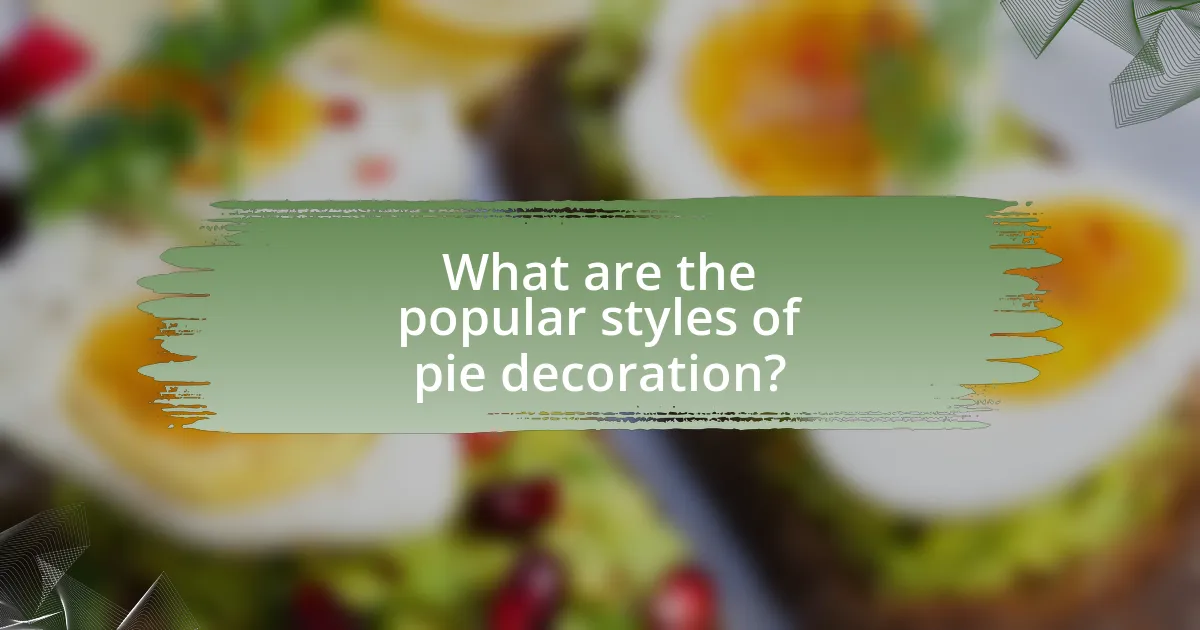
What are the popular styles of pie decoration?
Popular styles of pie decoration include lattice crusts, cut-out shapes, and decorative borders. Lattice crusts involve weaving strips of dough over the filling, creating a visually appealing pattern while allowing steam to escape. Cut-out shapes, often made from cookie cutters, can add thematic designs such as leaves or stars on top of the pie. Decorative borders, such as fluted or crimped edges, enhance the overall presentation and can be achieved through various techniques, including pinching or using a fork. These styles not only enhance the aesthetic appeal of pies but also reflect traditional baking practices.
How can lattice work elevate the appearance of a pie?
Lattice work can elevate the appearance of a pie by adding a visually appealing and intricate design that enhances its overall aesthetic. This technique involves weaving strips of dough over the filling, creating a pattern that not only showcases the ingredients inside but also adds depth and texture to the crust. The crisscross pattern of lattice work allows for steam to escape during baking, which can result in a perfectly baked filling while also providing an elegant presentation. Historically, lattice crusts have been used in various cultures, demonstrating their enduring popularity and effectiveness in pie decoration.
What techniques are used to create a perfect lattice crust?
To create a perfect lattice crust, bakers utilize techniques such as precise dough preparation, even rolling, and careful weaving. The dough should be chilled to maintain its structure, allowing for clean cuts and minimal shrinkage during baking. Even rolling ensures uniform thickness, which is crucial for consistent baking. When weaving the strips, alternating the over-and-under pattern creates an aesthetically pleasing design while allowing steam to escape. These techniques are validated by culinary experts who emphasize the importance of temperature control and technique in achieving a visually appealing and structurally sound lattice crust.
How can you incorporate decorative edges into your pie crust?
To incorporate decorative edges into your pie crust, you can use techniques such as crimping, fluting, or adding shapes. Crimping involves pinching the edges of the crust with your fingers or a fork to create a textured border. Fluting is achieved by pressing the crust between your fingers to form a wavy pattern. Additionally, you can cut shapes from excess dough, like leaves or stars, and attach them to the edges for added decoration. These methods not only enhance the visual appeal of the pie but also provide a professional finish, making the pie more inviting.
What are the benefits of using stencils in pie decoration?
Using stencils in pie decoration enhances visual appeal and precision. Stencils allow for intricate designs and patterns to be easily applied to the pie crust, creating a professional-looking finish that can elevate the overall presentation. This technique is particularly beneficial for achieving consistent shapes and sizes, which can be challenging to replicate by hand. Additionally, stencils can be used with various toppings, such as powdered sugar or cocoa, to add texture and contrast, making the pie more visually enticing. The use of stencils simplifies the decoration process, making it accessible for bakers of all skill levels, thus promoting creativity and experimentation in pie decoration.
How can stencils be used to create themed designs?
Stencils can be used to create themed designs by allowing bakers to apply intricate patterns and shapes onto pie crusts with precision. By placing a stencil over the dough and dusting it with flour, cocoa powder, or colored sugar, bakers can achieve detailed designs that align with specific themes, such as seasonal motifs or festive celebrations. This technique enhances the visual appeal of pies, making them more attractive and aligned with the intended theme, as evidenced by the popularity of stenciling in culinary arts for creating visually stunning desserts.
What materials are best for making pie stencils?
The best materials for making pie stencils are mylar, parchment paper, and plastic. Mylar is durable, flexible, and can withstand heat, making it ideal for intricate designs. Parchment paper is easily accessible and can be cut into various shapes, though it may not hold up as well for repeated use. Plastic stencils are reusable, easy to clean, and can be found in various designs, providing versatility for pie decoration. These materials are commonly used in baking due to their ability to create precise and clean patterns on pie crusts.
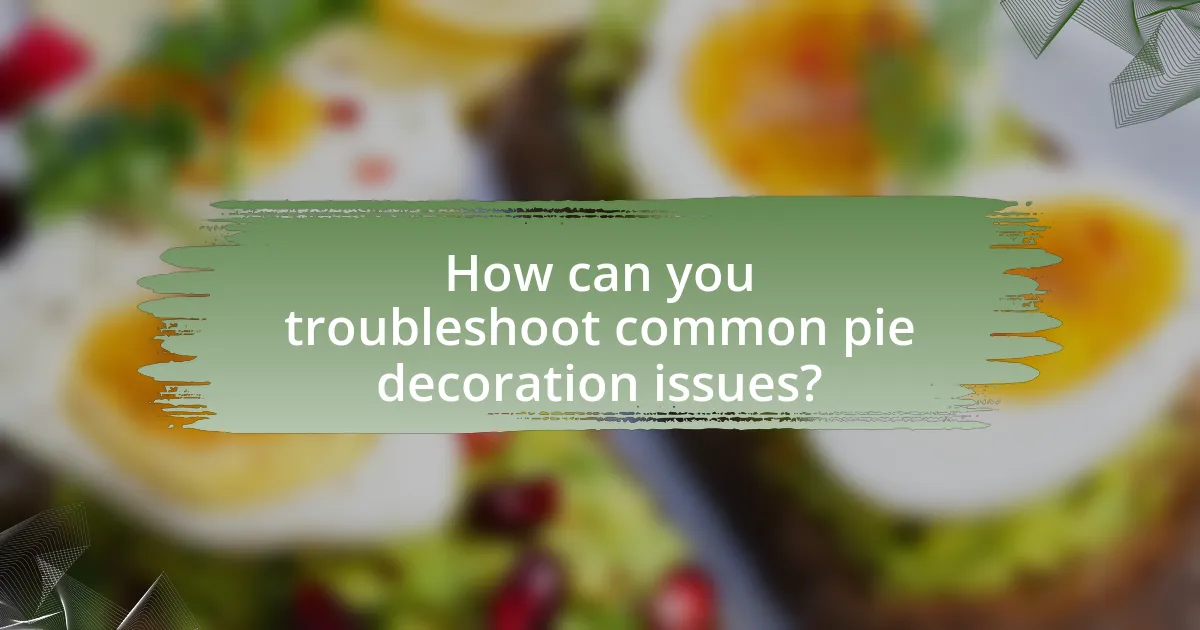
How can you troubleshoot common pie decoration issues?
To troubleshoot common pie decoration issues, first identify the specific problem, such as soggy crusts, uneven browning, or decorations that don’t adhere properly. For soggy crusts, ensure that the pie crust is pre-baked if necessary and that moisture from fillings is minimized. Uneven browning can be addressed by adjusting oven temperature or using a pie shield to protect the edges. If decorations are not adhering, use an egg wash or a bit of water to help them stick. These solutions are based on established baking practices that enhance the quality and appearance of pie decorations.
What are the most common mistakes in pie decoration?
The most common mistakes in pie decoration include improper crust handling, inadequate chilling of dough, and neglecting to create a decorative edge. Improper crust handling can lead to a tough texture, as overworking the dough develops gluten. Inadequate chilling of the dough before baking can result in shrinkage and loss of shape, as the fat in the dough melts too quickly. Neglecting to create a decorative edge can make the pie look unappealing and unprofessional, as a well-defined edge enhances visual appeal. These mistakes can significantly impact the overall quality and presentation of the pie.
How can overworking the dough affect the final look?
Overworking the dough can lead to a tough and dense final look, negatively impacting the texture and appearance of the crust. When dough is overworked, gluten develops excessively, resulting in a crust that lacks flakiness and can appear shiny or overly smooth instead of having a desirable, rustic texture. This is supported by culinary science, which indicates that optimal dough handling promotes a balance between gluten formation and tenderness, essential for an appealing pie crust.
What should you do if your crust shrinks during baking?
If your crust shrinks during baking, you should prevent this by ensuring proper dough preparation and handling. Overworking the dough can lead to gluten development, which causes shrinkage; therefore, handle the dough gently and avoid excessive kneading. Additionally, chilling the dough before baking allows the fats to solidify, which helps maintain its shape during the baking process. Studies show that resting the dough for at least 30 minutes can significantly reduce shrinkage, as it relaxes the gluten structure.
What tips can improve your pie decoration skills?
To improve your pie decoration skills, practice using various techniques such as lattice weaving, crimping edges, and creating decorative cutouts. Mastering lattice weaving involves cutting the dough into strips and arranging them in a crisscross pattern, which not only enhances visual appeal but also allows for steam to escape during baking. Crimping edges can be achieved by pinching the dough with fingers or using a fork, providing a polished finish that secures the filling. Additionally, using cookie cutters to create shapes from dough can add a personal touch and elevate the overall presentation. These techniques are widely recognized among bakers and are essential for creating visually stunning pies.
How can practice enhance your decorative techniques?
Practice enhances decorative techniques by allowing individuals to refine their skills and develop a deeper understanding of the materials and methods involved. Through consistent repetition, practitioners can improve their hand-eye coordination, gain familiarity with various tools, and experiment with different styles, leading to more intricate and aesthetically pleasing designs. Research indicates that deliberate practice can lead to mastery in artistic skills, as evidenced by studies showing that artists who engage in regular practice demonstrate significant improvements in their work quality and creativity.
What resources are available for learning advanced pie decoration?
Resources for learning advanced pie decoration include specialized cookbooks, online courses, and instructional videos. Notable cookbooks such as “Pie School” by Kate Lebo and “The Art of Pie” by Kate McDermott provide detailed techniques and recipes for intricate pie designs. Online platforms like MasterClass and Skillshare offer courses taught by professional bakers, focusing on advanced techniques such as lattice work and decorative crusts. Additionally, YouTube hosts numerous channels dedicated to baking, where expert bakers share tips and tutorials on pie decoration. These resources collectively enhance skills and knowledge in the art of pie decoration.
